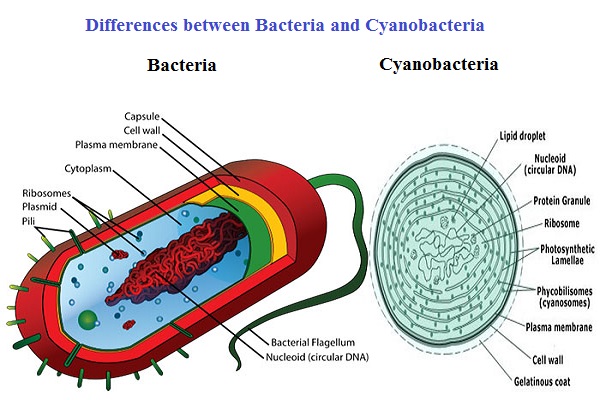Differences between Bacteria and Cyanobacteria
Differences between Bacteria and Cyanobacteria
Cyanobacteria is also known as blue-green algae. They differ from other bacteria in that cyanobacteria possess chlorophyll-a, while most bacteria do not contain chlorophyll. Chlorophyll-a gives them their characteristic blue-green color.
Differences between Bacteria and Cyanobacteria are given as follows:
| S.N. | Characters | Bacteria | Cyanobacteria |
| 1 | Size | Comparatively smaller. | Comparatively larger. |
| 2 | Distribution | Found every possible places in earth. | Only found in presence of sunlight and moisture. |
| 3 | Flagella | May bear flagella. | Flagella always absent. |
| 4 | Cell wall | 1-2 layered. | 4 layered. |
| 5 | Composition of cell wall | Glycolipids and peptidoglycan. | Cellulose and pectin. |
| 6 | Nutrition | May be autotrophic or heterotrophic. | Usually autotrophic. |
| 7 | Photosynthetic pigments | Photosynthetic pigment is bacteriochlorophyll. | Photosynthetic pigments is chlorophyll a. |
| 8 | Accessory pigment | Absent | Accessory pigment like phycocyanin and phycoerythrin are present in dominating form. |
| 9 | Reserve food | Glycogen | Cyanophycean starch |
| 10 | Spore formation | Is endogenous. | Is not endogenous. |
| 11 | Hydrogen donor | During photosynthesis hydrogen donor is not water; as a result oxygen is not evolved. Thus photosynthesis is anoxygenic. | Hydrogen donor is water, oxygen is evolved. Process is oxygenic. |
| 12 | Locomotory organ | Flagella act as locomotory organ. | Lack flagella and other locomotory organ. |
| 13 | Heterocyst | Absent | Present. |
| 14 | Sexual reproduction | Takes place by conjugation, transformation and transduction. | Totally absent. |
References:
- Biologyexams4u
- wisebrain.info
- A textbook of Biology.
- Reader’s Smooth Biology.
Differences between Bacteria and Cyanobacteria
(Visited 71,728 times)


THE BEST DIFF EVER IT CLEAR OUR CONCEPTS MORE AND MOST
Arrreee it’s very clearly description and difference here
Thanks
what is photosynthetic lamellae and chloroplast?